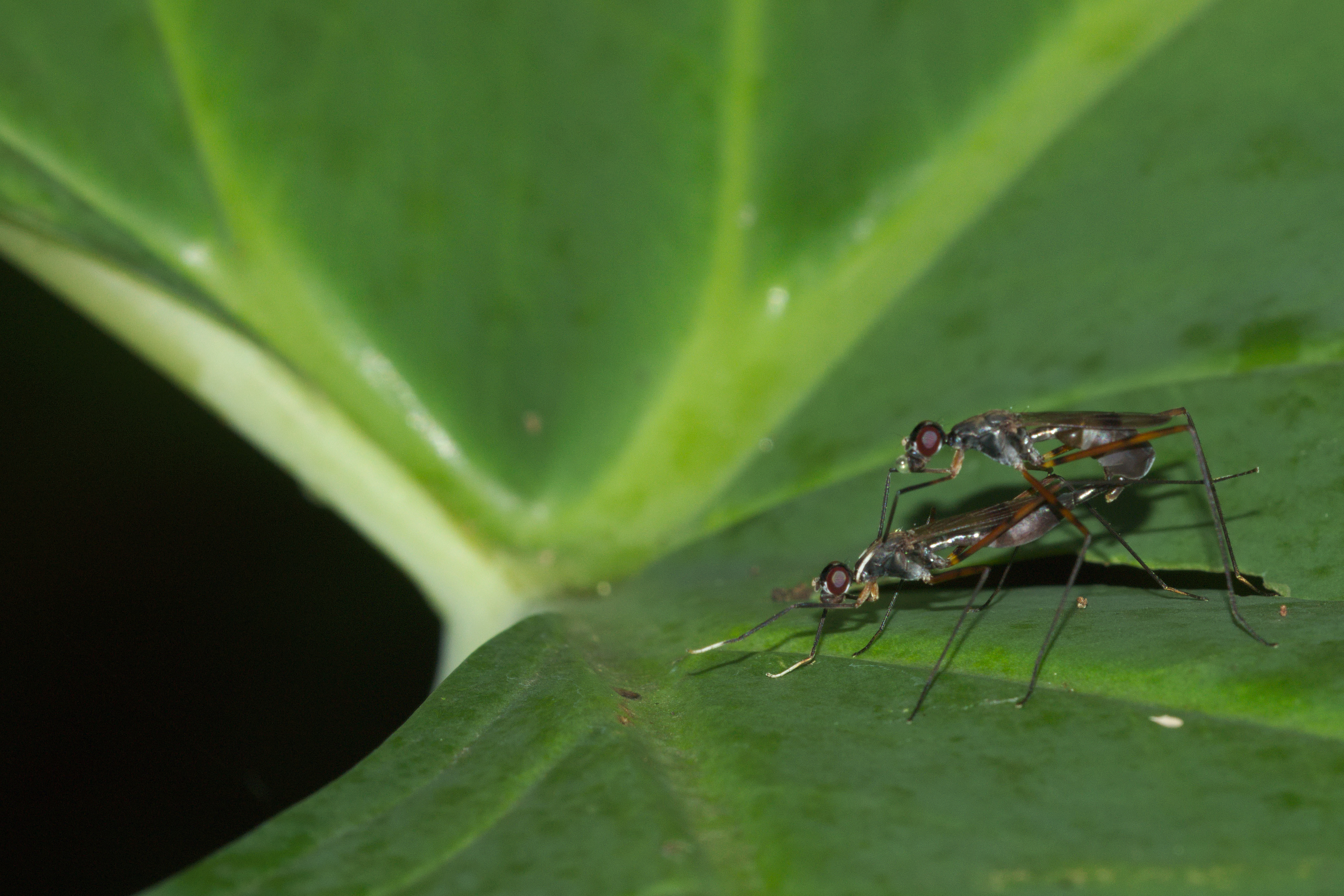|
Stilt-legged Fly
The Micropezidae are a moderate-sized family of acalyptrate muscoid flies in the insect order Diptera, comprising about 500 species in about 50 genera and five subfamilies worldwide, (except New Zealand and Macquarie Island).McAlpine, D.K. (1998). Review of the Australian stilt flies (Diptera: Micropezidae) with a phylogenetic analysis of the family. ''Invertebrate Taxonomy'' 12:55–134. (with key to Australian species) They are most diverse in tropical and subtropical habitats, especially in the Neotropical Region. Insects in this family are commonly called stilt-legged flies, after their characteristically long legs. The fore legs are markedly smaller than the other pairs. Mostly, they are long-bodied, often black flies, usually with infuscated (darkened) wings. Wings are reduced in the genera '' Calycopteryx'' and entirely absent in the ant-like '' Badisis ambulans''. Description For terms see Morphology of Diptera Very slender, small to large (3–16 mm) flies, t ... [...More Info...] [...Related Items...] OR: [Wikipedia] [Google] [Baidu] |
Hermann Loew
Friedrich Hermann Loew (19 July 1807 – 21 April 1879) was a German entomologist who specialised in the study of Diptera, an order of insects including flies, mosquitoes, gnats and midges. He described many world species and was the first specialist to work on the Diptera of the United States. Biography Early years Hermann Loew was born in Weissenfels, Saxony a short distance south of Halle (Germany). The Loew family, though not wealthy, was well-placed. Loew's father was a functionary for the Department of Justice of the Duchy of Saxony who later became a ''Geheimer Regierungsrath'' of Prussia. Between 1817 and 1829 Loew attended first the Convent school of Rossleben, then the University of Halle-Wittenberg, graduating in mathematics, philology and natural history. Teacher, tutor and husband Recognizing his abilities as a mathematician, the university, on his graduation, appointed him as a lecturer in the same subjects. In 1830 he went to Berlin and gave lessons in dif ... [...More Info...] [...Related Items...] OR: [Wikipedia] [Google] [Baidu] |
Micropeza Corrigiolata - 2013-06-03
''Micropeza'' is a genus of stilt-legged flies in the family Micropezidae. Description These stilt-legged flies have no crossvein separating discal cells and the second basal cell of the wing. Fronto‑orbital setaeare absent. Costa is bare from base to end of subcostal vein. Occiput is very prominent and has postvertical bristles. The four posterior tibiae have small bristles. Species Species within this genus include: * '' Micropeza abnormis'' * '' Micropeza afghanistanica'' * '' Micropeza albiseta'' * '' Micropeza ambigua'' * '' Micropeza angustipennis'' * ''Micropeza annulata'' * ''Micropeza annulipes'' * '' Micropeza annuliventris'' * '' Micropeza appendiculata'' * '' Micropeza argentiniensis'' * '' Micropeza armipennis'' * ''Micropeza atra'' * ''Micropeza atripes'' * ''Micropeza atriseta'' * ''Micropeza biannulata'' * ''Micropeza bilineata'' * ''Micropeza bisetosa'' * '' Micropeza bogotana'' * '' Micropeza brasiliensis'' * ''Micropeza brevipennis'' * ''Micropeza brevira ... [...More Info...] [...Related Items...] OR: [Wikipedia] [Google] [Baidu] |
Excrement
Feces ( or faeces), known colloquially and in slang as poo and poop, are the solid or semi-solid remains of food that was not digested in the small intestine, and has been broken down by bacteria in the large intestine. Feces contain a relatively small amount of metabolic waste products such as bacterially altered bilirubin, and dead epithelial cells from the lining of the gut. Feces are discharged through the anus or cloaca during defecation. Feces can be used as fertilizer or soil conditioner in agriculture. They can also be burned as fuel or dried and used for construction. Some medicinal uses have been found. In the case of human feces, fecal transplants or fecal bacteriotherapy are in use. Urine and feces together are called excreta. Skatole is the principal compound responsible for the unpleasant smell of feces. Characteristics The distinctive odor of feces is due to skatole, and thiols (sulfur-containing compounds), as well as amines and carboxylic acids. Skat ... [...More Info...] [...Related Items...] OR: [Wikipedia] [Google] [Baidu] |
Calobata
''Calobata'' is a genus of flies belonging to the family Micropezidae. The genus was first described by Meigen in 1803. The species of this genus are found in Europe and Northern America. Species include: * ''Calobata petronella ''Calobata petronella'' is a species of fly in the family Micropezidae. It is found in the Palearctic The Palearctic or Palaearctic is the largest of the eight biogeographic realms of the Earth. It stretches across all of Eurasia north of the ...'' References {{Taxonbar, from=Q14717608 Micropezidae ... [...More Info...] [...Related Items...] OR: [Wikipedia] [Google] [Baidu] |
Predation
Predation is a biological interaction In ecology, a biological interaction is the effect that a pair of organisms living together in a community have on each other. They can be either of the same species (intraspecific interactions), or of different species ( interspecific interactio ... where one organism, the predator, kills and eats another organism, its prey. It is one of a family of common feeding behaviours that includes parasitism and micropredation (which usually do not kill the host) and parasitoidism (which always does, eventually). It is distinct from scavenging on dead prey, though many predators also scavenge; it overlaps with herbivory, as seed predators and destructive frugivores are predators. Predators may actively search for or pursue prey or wait for it, often concealed. When prey is detected, the predator assesses whether to attack it. This may involve ambush predation, ambush or pursuit predation, sometimes after stalking the prey. If the attack ... [...More Info...] [...Related Items...] OR: [Wikipedia] [Google] [Baidu] |
Ginger
Ginger (''Zingiber officinale'') is a flowering plant whose rhizome, ginger root or ginger, is widely used as a spice and a folk medicine. It is a herbaceous perennial which grows annual pseudostems (false stems made of the rolled bases of leaves) about one meter tall bearing narrow leaf blades. The inflorescences bear flowers having pale yellow petals with purple edges, and arise directly from the rhizome on separate shoots. Ginger is in the family Zingiberaceae, which also includes turmeric (''Curcuma longa''), cardamom (''Elettaria cardamomum''), and galangal. Ginger originated in Maritime Southeast Asia and was likely domesticated first by the Austronesian peoples. It was transported with them throughout the Indo-Pacific during the Austronesian expansion ( BP), reaching as far as Hawaii. Ginger is one of the first spices to have been exported from Asia, arriving in Europe with the spice trade, and was used by ancient Greeks and Romans. The distantly related di ... [...More Info...] [...Related Items...] OR: [Wikipedia] [Google] [Baidu] |
Detritivore
Detritivores (also known as detrivores, detritophages, detritus feeders, or detritus eaters) are heterotrophs that obtain nutrients by consuming detritus (decomposing plant and animal parts as well as feces). There are many kinds of invertebrates, vertebrates and plants that carry out coprophagy. By doing so, all these detritivores contribute to decomposition and the nutrient cycles. They should be distinguished from other decomposers, such as many species of bacteria, fungi and protists, which are unable to ingest discrete lumps of matter, but instead live by absorbing and metabolizing on a molecular scale ( saprotrophic nutrition). The terms ''detritivore'' and ''decomposer'' are often used interchangeably, but they describe different organisms. Detritivores are usually arthropods and help in the process of remineralization. Detritivores perform the first stage of remineralization, by fragmenting the dead plant matter, allowing decomposers to perform the second stage of ... [...More Info...] [...Related Items...] OR: [Wikipedia] [Google] [Baidu] |
Herbivore
A herbivore is an animal anatomically and physiologically adapted to eating plant material, for example foliage or marine algae, for the main component of its diet. As a result of their plant diet, herbivorous animals typically have mouthparts adapted to rasping or grinding. Horses and other herbivores have wide flat teeth that are adapted to grinding grass, tree bark, and other tough plant material. A large percentage of herbivores have mutualistic gut flora that help them digest plant matter, which is more difficult to digest than animal prey. This flora is made up of cellulose-digesting protozoans or bacteria. Etymology Herbivore is the anglicized form of a modern Latin coinage, ''herbivora'', cited in Charles Lyell's 1830 '' Principles of Geology''.J.A. Simpson and E.S.C. Weiner, eds. (2000) ''The Oxford English Dictionary'', vol. 8, p. 155. Richard Owen employed the anglicized term in an 1854 work on fossil teeth and skeletons. ''Herbivora'' is derived from Latin ... [...More Info...] [...Related Items...] OR: [Wikipedia] [Google] [Baidu] |
Anaeropsis
''Anaeropsis'' is a genus of stilt-legged fly. It is found in New Guinea. Species *''Anaeropsis guttipennis'' (Walker Walker or The Walker may refer to: People *Walker (given name) *Walker (surname) *Walker (Brazilian footballer) (born 1982), Brazilian footballer Places In the United States *Walker, Arizona, in Yavapai County *Walker, Mono County, California * ..., 1861) References Micropezidae Nerioidea genera Insects of New Guinea {{Nerioidea-stub ... [...More Info...] [...Related Items...] OR: [Wikipedia] [Google] [Baidu] |
Ichneumonidae
The Ichneumonidae, also known as the ichneumon wasps, Darwin wasps, or ichneumonids, are a family of parasitoid wasps of the insect order Hymenoptera. They are one of the most diverse groups within the Hymenoptera with roughly 25,000 species currently described. However, this likely represents less than a quarter of their true richness as reliable estimates are lacking, along with much of the most basic knowledge about their ecology, distribution, and evolution.Quicke, D. L. J. (2015). The braconid and ichneumonid parasitoid wasps: biology, systematics, evolution and ecology. Chichester: John Wiley & Sons, Ltd. Ichneumonid wasps, with very few exceptions, attack the immature stages of holometabolous insects and spiders, eventually killing their hosts. They thus fulfill an important role as regulators of insect populations, both in natural and semi-natural systems, making them promising agents for biological control. The distribution of the ichneumonids was traditionally consi ... [...More Info...] [...Related Items...] OR: [Wikipedia] [Google] [Baidu] |
Wasp
A wasp is any insect of the narrow-waisted suborder Apocrita of the order Hymenoptera which is neither a bee nor an ant; this excludes the broad-waisted sawflies (Symphyta), which look somewhat like wasps, but are in a separate suborder. The wasps do not constitute a clade, a complete natural group with a single ancestor, as bees and ants are deeply nested within the wasps, having evolved from wasp ancestors. Wasps that are members of the clade Aculeata can Stinger, sting their prey. The most commonly known wasps, such as yellowjackets and hornets, are in the family Vespidae and are Eusociality, eusocial, living together in a nest with an egg-laying queen and non-reproducing workers. Eusociality is favoured by the unusual haplodiploid system of sex-determination system, sex determination in Hymenoptera, as it makes sisters exceptionally closely related to each other. However, the majority of wasp species are solitary, with each adult female living and breeding independently ... [...More Info...] [...Related Items...] OR: [Wikipedia] [Google] [Baidu] |



_with_its_prey.jpg)


_grazing_-_20050809.jpg)
